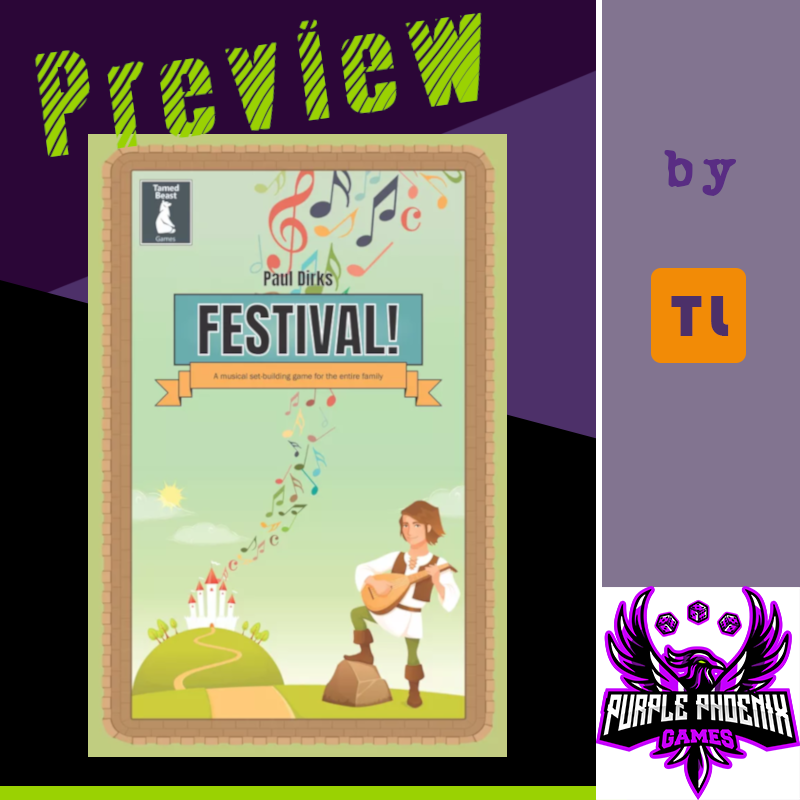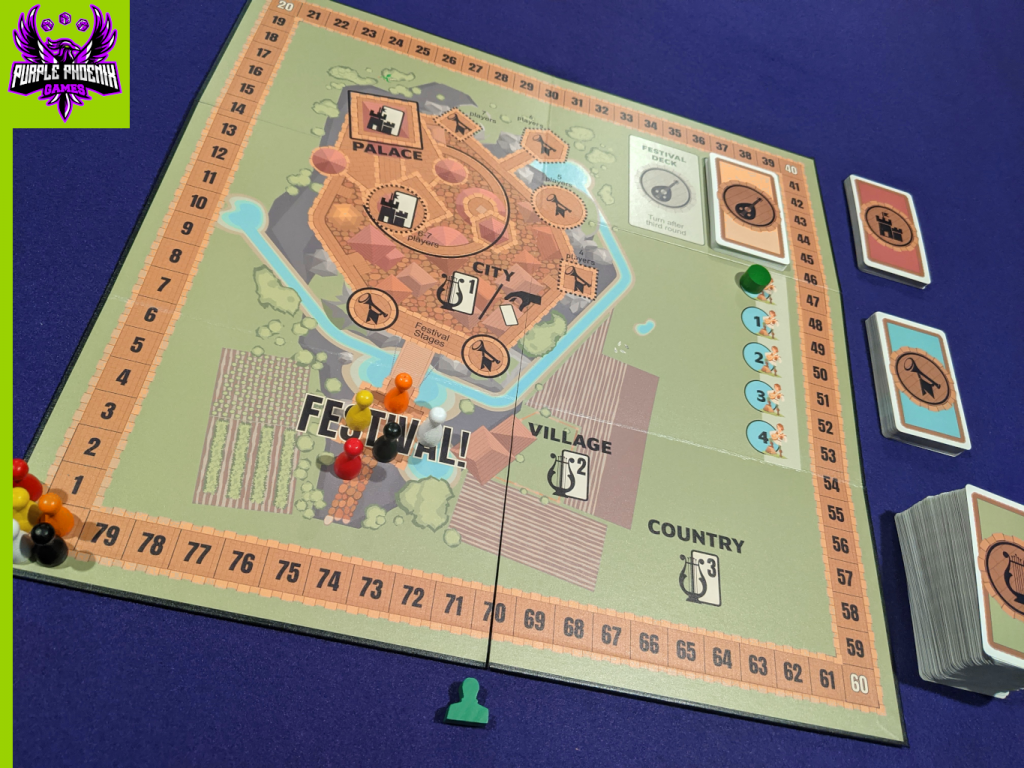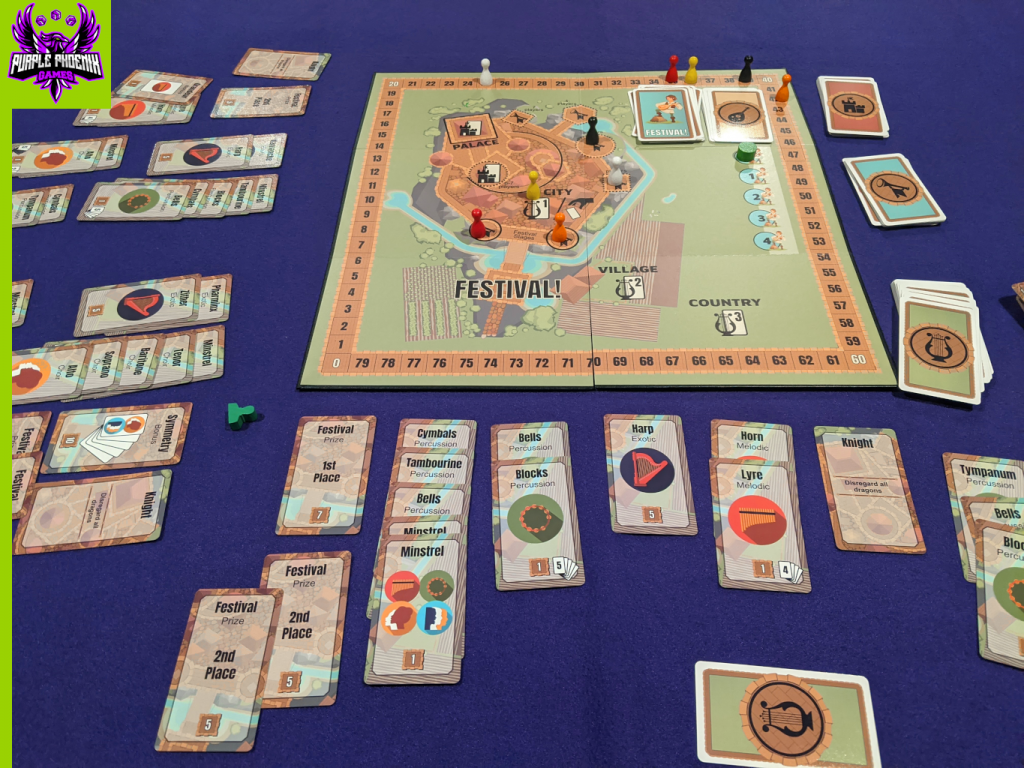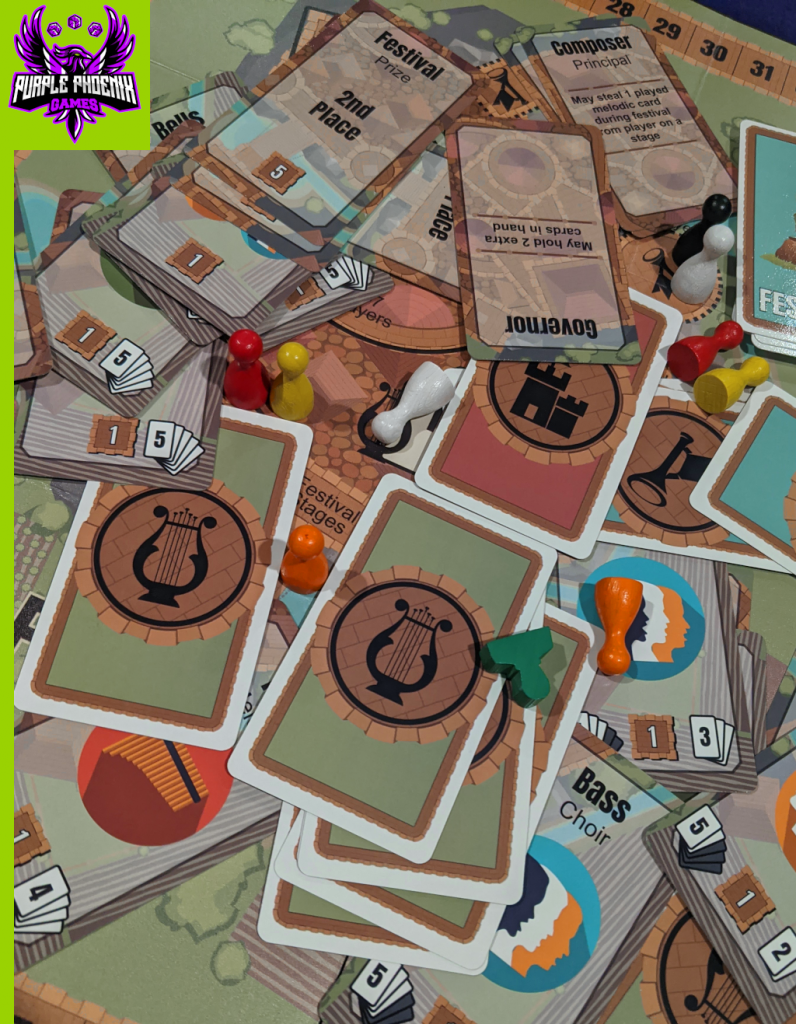
Remember music festivals, or concerts of any kind? I most certainly do. I used to perform almost every weekend with my band pre-COVID. Well, I haven’t performed in over eight months as of this writing. I miss it so much. So when I heard that a designer was working on a game about musicians putting on music festivals I just had to check it out.
| Festival! (2020) | Tamed Beast Games |
| 3-7 Players | 30-60 minutes |
| Ages 7+ | BGG Weight – (not yet available) |
Festival! is a competitive set collection game for larger groups, three to seven players. It is set in a medieval kingdom and the game lasts for four festivals. During the game players will be collecting sets of cards to be scored immediately and collecting other cards to be scored at the game’s end.
DISCLAIMER: We were provided a prototype copy of this game for the purposes of this review. These are preview copy components, and I do not know for sure if the final components will be any different from these shown. Also, it is not my intention to detail every rule in the game, but give an idea of how the game plays. You are invited to download the rulebook, back the game through the forthcoming Kickstarter campaign, or through any retailers stocking it after fulfillment. -T
To setup, place the board in the middle of the table. Each player chooses a color of pawn to represent them and places one pawn on the 0 space upon the scoring track and the other pawn in the Festival! area upon the board. The game comes with four different types of cards and each type will be shuffled and placed face-down in stacks as in the photo below. Place the festival marker on either the 0 or 4 space (the rules are not clear, but it is to track the number of festivals, so just choose one) and give the first player busteeple to the youngest player. The game may now begin.

Festival! is played over several turns, but the first three turns will see players taking turns to travel to the different areas of the board and collect cards once they arrive. The initial Festival! area is located between the City and Village areas so a player can choose to move their pawn into either of those areas. As is printed on the board areas themselves, when players arrive in the Country they will immediately draw three Ensemble (green) cards to their hand and their turn is over. A trip to the Village affords the player two Ensemble cards to be drawn, while a visit to the City will allow a player to either draw one Ensemble card OR play as many cards from their hand as they choose. Finally, should the player’s wanderlust urge them to the Palace, they may draw a Palace card to be played to their tableau immediately. Movement from one area to the next is always done to the adjacent area. So if in the Village a player may only move to either the Country or the City. If in the Country a player may only move to the Village.
As I mentioned, the first three turns are head start rounds where players are merely collecting cards to amass a hand (of limit 7) of cards that can be played in sets in their personal tableau. These cards are divided into Exotic, Percussion, Melodic, and Choir cards. Players may play as many cards as they like when in the City, but will score bonus set and superset points if they are able to lay down multiple unique cards in each group. For example, a Horn card is worth one VP alone, but with three other unique Melodic cards earns bonus points for the entire set.
After the first three turns have been played, the first player will then flip a Festival card (stacked on the game board) at the beginning of each turn. It is from this stack that the four “Festival!” cards are located, and they are the time trackers for the game. If the result is “Preparation,” the turns continue as normal with no change. However, should the flipped card be a “Festival!” face, then players within range of the Festival Stages may claim a stage and participate in the festival. Participation in the festival simply means that players may play cards as normally played in the City, but then are entitled to one of the drawn Finale cards. These cards are scored at the end of the game and typically award bonus points for various reasons.
Play continues in this fashion of traveling the board areas to collect cards, performing in festivals, and earning the most amount of VP at game end, which is immediately following the fourth festival. The player with the most VP is the winner!

Components. Again, this is a prototype copy of the game, so the components may be different upon completion of a successful Kickstarter campaign. What we were provided, however, is a good-looking, though muted, game board, a ton of cards, and some painted wooden tokens. The tokens are fine, and I am sure will look different once the game is finalized. The cards are good, an interesting dimension, and the art upon them is good and simple. In fact, the cards’ art remind me of several computer icon sets, specifically Shadow or Sardi (though I use Sweet-Rainbow).
But how does it play? Okay, every time I get a new game I always play it solo multi-handed. During this initial play I had several questions for the designer about scenarios and other oddities that were not covered in the rulebook. He graciously, and immediately, answered my questions and the next play through ran quite smoothly. So I am sure the rulebook will be tweaked quite a bit before final production.
Once I was playing the right way the game ran smoothly and quickly. I found myself planning my turn in advance, however your success truly is dependent on the cards you draw. Ensemble cards are just the instruments, voices, and Minstrel (wild) cards, while the Palace cards are the rule-breaking fun cards. They allow increased travel, protection from certain cards in the deck, and other goodies I won’t spoil here. So having a nice collection of Palace cards can alleviate a lot of the random card draw issues that will plague players who refuse to grab the Palace cards. As I played more and more I found that I generally follow one strategy, but have to switch up tactics depending on my card draws. This is good and okay (not “bad”). Going in with a plan of attack is great, and being able to become flexible mid-game is enjoyable.
Overall this one is surprising to me because I was initially frustrated with the vague rulebook, but once I truly knew the real rules and how everything played together I found a real fondness for it. Festival! will probably never make it close to my Top 10 Games of All Time list, but for larger groups who are tiring of the hidden traitor or social deduction games, this one is a breath of fresh air. It can handle up to seven players, and is an easier teach than many other games for mid-to-large groups.
So if you are looking for something different for a weird player count, and you need some more medieval rock star games in your collection please check out Festival!. (Do I need the period there or am I covered with the exclamation point from the title of the game? I was not an English major.) I think you will be pleasantly surprised at how this unassuming set collection game (with aspects of take-that which I did not explore here) will perform. I am looking forward to following the Kickstarter campaign set to launch in Spring 2021, so keep it on your radars, people.

